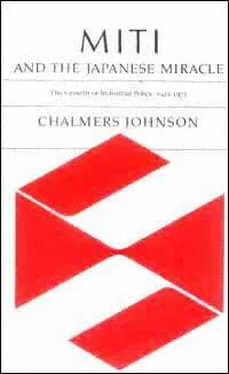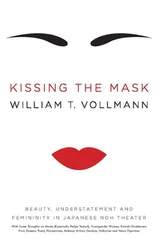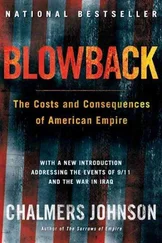Chalmers Johnson - MITI and the Japanese miracle
Здесь есть возможность читать онлайн «Chalmers Johnson - MITI and the Japanese miracle» весь текст электронной книги совершенно бесплатно (целиком полную версию без сокращений). В некоторых случаях можно слушать аудио, скачать через торрент в формате fb2 и присутствует краткое содержание. Год выпуска: 2007, Издательство: Stanford University Press, Жанр: Старинная литература, на английском языке. Описание произведения, (предисловие) а так же отзывы посетителей доступны на портале библиотеки ЛибКат.
- Название:MITI and the Japanese miracle
- Автор:
- Издательство:Stanford University Press
- Жанр:
- Год:2007
- ISBN:нет данных
- Рейтинг книги:3 / 5. Голосов: 1
-
Избранное:Добавить в избранное
- Отзывы:
-
Ваша оценка:
- 60
- 1
- 2
- 3
- 4
- 5
MITI and the Japanese miracle: краткое содержание, описание и аннотация
Предлагаем к чтению аннотацию, описание, краткое содержание или предисловие (зависит от того, что написал сам автор книги «MITI and the Japanese miracle»). Если вы не нашли необходимую информацию о книге — напишите в комментариях, мы постараемся отыскать её.
MITI and the Japanese miracle — читать онлайн бесплатно полную книгу (весь текст) целиком
Ниже представлен текст книги, разбитый по страницам. Система сохранения места последней прочитанной страницы, позволяет с удобством читать онлайн бесплатно книгу «MITI and the Japanese miracle», без необходимости каждый раз заново искать на чём Вы остановились. Поставьте закладку, и сможете в любой момент перейти на страницу, на которой закончили чтение.
Интервал:
Закладка:
kogyo
* newspapers broke the story that a Yawata-Fuji merger was in the works. This scoop generated a public furor that was rivaled only by the controversy over the Special Measures Law four years earlier. A group of economists at Tokyo University led by Professor Uchida Tadao met and issued a formal statement arguing that the proposed steel merger was economically unsound and would lead to monopolistic price increases. Uchida also contended that "what is really significant about the case is the absence of concern for the legal, economic, and social implications of so large a merger, as well as the widespread belief that the acts of private enterprises are not based on their own independent decisions but on the administrative guidance of MITI."
11
Uchida was particularly concerned that the Japanese public did not understand the economic need for competition and for defending it through the legal system.
The Fair Trade Commission listened to all of this and on January 27, 1969, clarified its position on the legal requirements for mergers. The commission did not necessarily oppose mergers that resulted in the formation of the largest enterprise in an industryso long as it could be convinced that the new corporation would be unable to compel its competitors to follow its pricing decisions simply because of its size. On this basis, a month later (February 24) the commission formally declared that it would approve the Yawata-Fuji merger only if each company divested itself of certain key subsidiaries that, if retained, would give the new company price control over the steel industry. Inayama and Nagano resisted this decision, even though Sanken's Nakayama had already warned them that sales of some facilities would be unavoidable, and tried to mobilize political influence against the FTC. As a consequence, on May 7, 1969, the FTC for the first time in its existence went to the Tokyo High Court and got a restraining order against a merger. The fat was now definitely in the fire.
During June 1969 the Tokyo High Court held public hearings on the merger; the FTC presented its position, as did the professors, the companies, consumer groups, and related industriesand MITI in
Page 283
the person of Sakon Tomosaburo *, chief of the Steel Industry Section in MITI's Heavy Industries Bureau, who made the unfortunate public comment that in this court the "laymen are judging the professionals." The press covered the hearings extensively. On October 30, 1969, the court finally ruled that the merger could proceed only if Fuji sold one of its plants to Nippon Kokan* and Yawata turned over one of its installations to Kobe Steel. Both companies reluctantly complied, and New Japan Steel, the world's largest steel company, formally came into being on March 31, 1970. Three years later, on May 30, 1973, former MITI Vice-Minister Hirai Tomisaburo*, who had retired in 1955 and entered Yawata, became president of the country's largest enterprise. Although Hirai was widely respected as a leader of the steel industry, this elevation of a former bureaucrat to the top position of a company long associated with the government led some to see a trend toward excessive bureaucratic influence in the economy.
12
MITI, of course, was totally identified with the steel merger, if for no other reason than that the chief executives of the new company, including Ojima Arakazu, Inayama Yoshihiro, Hirai Tomisaburo, and Tokunaga Hisatsugu, were all former MCI or MITI officials. Because of this and several other issues that came to a head at precisely the same time that the steel case ended up in court, MITI was subjected to some of the most withering criticism it had ever endured in its long history. The contemporaneous foreign criticism of the ministryJames Abegglen's term "Japan, Inc." and the London
Economist
's references to "notorious MITI"never fazed MITI officials, but domestic criticism was taken seriously. The main issues raised by domestic critics, in addition to the steel merger, were environmental damage, overcrowding, alleged collusion with big business, and a host of other side effects of high-speed growth that the public demanded be addressed. And as if this were not enough, right in the midst of all these problems the ministry experienced the most serious revolt ever against its administrative guidance, a blow that signified a genuine turning point in its relations with big business.
The issue of industrial pollution and environmental damage had numerous facets. At its worst it referred to the appearance of the Minamata and
itai-itai
"diseases," caused respectively by mercury poisoning of the waters around Minamata village in Kumamoto prefecture by the Chisso Fertilizer Company and cadmium poisoning in Toyama prefecture and other locations. (In September 1969 the chief of the Tokyo Mine Safety Office, a division of MITI, committed suicide when cadmium contamination was confirmed in Gunma prefecture.)
13
Only slightly less serious was the so-called Yokkaichi asthma
Page 284
that seemed to afflict everyone in the big petrochemical complexes at Yokkaichi and Tokuyama. As the press revealed, many of these conditions had actually been diagnosed as early as 1955 but had elicited no governmental corrective measures. The blame was laid squarely at MITI's door.
More politically significant because they affected so many people were air pollution in all the major cities (it was predicted that a chic, well-designed gas mask would soon become as indispensable an item of personal daily use as the umbrella), and automobile and truck accidents (because of inadequate expenditures on highways and alleged insensitivity to safety in automobile design). Noise, crowding, and the shortage of land for housing in the big cities also led many to question the value of high-speed growth. Organizations of local residents and consumers were created to protect such things as ''sunshine rights," that is, the right of a resident not to have all sunshine blocked by an intervening high-rise. The word
kogai
* ("pollution," or more literally, "public wound") appeared in the newspapers every day.
During 1967 the Diet enacted the Pollution Countermeasures Basic Law (Kogai* Taisaku Kihon Ho, number 132 of August 3), which set standards for seven kinds of pollution: air, water, soil (added in 1970), noise, vibration, subsidence, and offensive odors. However, on MITI's insistence the Diet modified article 1 of the Ministry of Welfare's draft law to add that antipollution measures must be "in harmony with the healthy development of the economy."
14
This effectively gutted the law. But as pollution problems intensified, the politicians ultimately had no choice but to overrule the ministry. The result was the famous "pollution Diet" (
kogai kokkai
, the 64th session, November 24 to December 18, 1970), which passed some fourteen antipollution laws and removed the phrase "in harmony with the economy" from the basic law. MITI had finally gotten the point; on July 1, 1970, it renamed its Mine Safety Bureau the Environmental Protection and Safety Bureau (Kogai Hoan Kyoku) and increased its budget for dealing with industrial pollution problems from ¥274 million (1970) to ¥638 million (1971). A decade later MITI was to be credited with carrying out one of the most effective industrial cleanup campaigns in history, and in the process it also developed a thriving new industry in antipollution devices.
15
But in 1970 no one was thanking it, nor did many think that it could do the job.
In addition to being held responsible for the pollution problem, MITI was also blamed for damaging relations with the United States.
Page 285
The Nixon administration, elected in 1968, was publicly committed to obtaining limitations on Japanese exports of synthetic textiles to America, just as the Kennedy administration had earlier negotiated an "orderly marketing agreement" covering cotton textiles. Both administrations were responding to political demands from the American Textile Manufacturers Institute, who used the potent argument that imports were putting many of the blacks among their employees out of work. (It should be noted that Japan has consistently and successfully prohibited imports of leather goods on the grounds that these would compete with the domestic industries of the
Читать дальшеИнтервал:
Закладка:
Похожие книги на «MITI and the Japanese miracle»
Представляем Вашему вниманию похожие книги на «MITI and the Japanese miracle» списком для выбора. Мы отобрали схожую по названию и смыслу литературу в надежде предоставить читателям больше вариантов отыскать новые, интересные, ещё непрочитанные произведения.
Обсуждение, отзывы о книге «MITI and the Japanese miracle» и просто собственные мнения читателей. Оставьте ваши комментарии, напишите, что Вы думаете о произведении, его смысле или главных героях. Укажите что конкретно понравилось, а что нет, и почему Вы так считаете.












